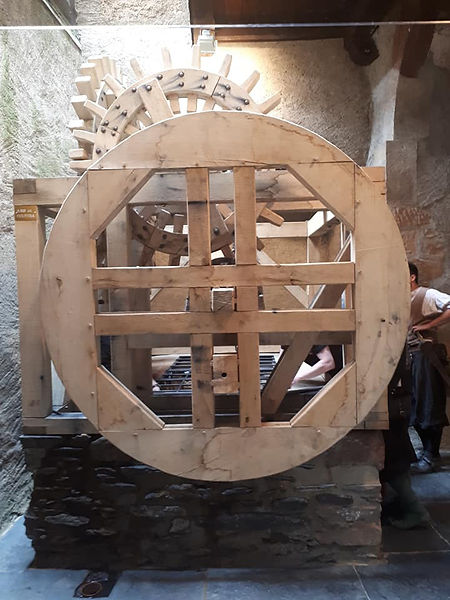
water supply of a castle
Water is most important to a forteress, as without no life is possible. So castle engineers had to make sure there was always enough water to keep a garrison alife during a siege.
There are three possiblitities to get water to a castle, and all three were used at some point in Vianden.
water pipe

In the 16th century a water pipe made partially of hollowed tree trunks, partially of clay tubes was installed to bring water from a nearby spring in the forest to the castle. Unfortunately this didn't work too well, and it was too vulnerable to aggressors, so it wasn't used later any more.
a shaft cut into the rock

The well was dug possibly in the 12th century at the bottom of an old roman ditch. The original access platform was one storey beneath todays access; it seems sensible to suppose that the access was rised to today's level with the construction of the great hall & the stately kitchen around 1200.
While the well shaft is round, it is crowned by a rectangular opening, resting on arches. The reason for this rectangular opening is the medieval hoist technique: An axle tree ran over the opening. A long rope was twined in a good number of loops around the axle tree, with a bucket attached on each free hanging rope end. Turning the axle tree made the rope unroll at one end, sending the bucket to the depth of the well, and onroll at the other end, lifting the other bucket up. The process of un- and onrolling made the rope slip slowly along the axle tree, therefore a long opening was needed.
In the 16th century this rope mechenaism was replaced with a chain mechanism, as now it was possible to produce such heavy steel chains.
In 1622 the hoist was replaced by another chain mechanism. This had two buckets of 80 litres / 18 gallons emptying automatically into two stone basins of 400 litres / 90 gallons each.
reconstruction of the well hoist mechanism

In 2016 the well hoist mechanism was reconstructed, which was made possible by detailled information found inside the castle accounts and research about hoist mechanisms. The structure looks amazingly huge and quasi industrial; one doesn't necessarily expect such a thing at a castle. But to remember: There was need to provide the whole castle with water; the daily need would have been around 800 litres / 180 gallons - the quantity fitting into the stone basins which stood here and taking around an hour of work for two men to lift up ...


